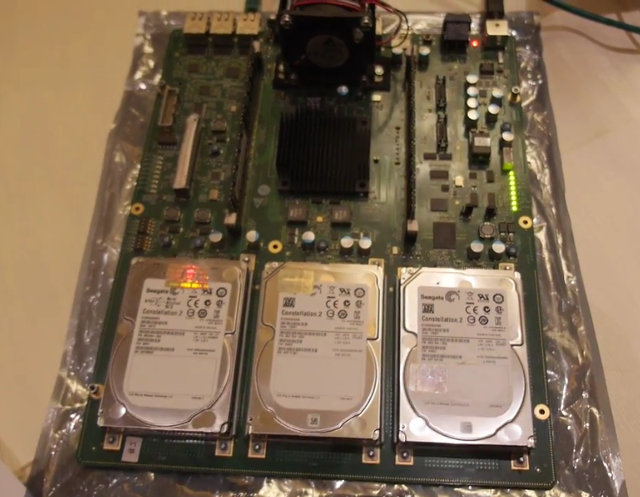During Linaro 14.02 release, I noticed a Huawei D01 board with 16 ARM Cortex A15 core, but details were lacking. Charbax was a Linaro Connect Asia earlier this month, and he could film the board in action, and interview the development team about this server board, and software development.

Huawei D01 specifications:
- Processor
- HiSilicon SoC with16 x ARM Cortex-A15 CPU Core @ max. 1.5GHz (up to 84000 DMIPS)
- Support for CPU configuration as AMP/SMP
- Configurable Big or Little endian. Default: Little endian
- System Memory – 2x 64bit DDR3 DRAM Dual Inline Memory up to 1600 MHz, Module(DIMM) sockets:(2)&(3) . Default capacity: 8GB, upgradeable to 64GB
- Storage – 2x 1Gb NOR Flash, 2x 512MB NAND Flash, 3x SATA III for 2.5″ hard drives or SSD, 1x SD card
- Connectivity – 2x 10/100/1000Mbit/s Gigabit Ethernet ports, 1x 10/100Mbit/s FE port
- Other Peripheral Interfaces
- 2x USB 2.0 Host ports
- 2x UART, 4x I2C, 2x SPI supporting four CSs
- GPIO – 8x LED interfaces, 8x switches
- 2x Tracer Connector
- 1x JTAG interfaces( 5×2 pin CPU Connector, ARM Connector)
- Expansions – 1x PCI Express interfaces, 3x MDIO interfaces
- Hardware Monitor Subsystem – Power consumption sense
- Misc – Power-off and reset buttons
The BIOS resides in the NOR Flash and support update via FTP. The board runs Ubuntu server OS with Linux 3.13 (upgraded to 3.14 soon), and the target market is mostly cloud based applications. Linaro will use the board for developing software for Hisilicon, and as a native ARM build machine.
Watch the video below. Warning: Noisy ARM server!
You can find more technical details on Linaro D01 page.

Jean-Luc started CNX Software in 2010 as a part-time endeavor, before quitting his job as a software engineering manager, and starting to write daily news, and reviews full time later in 2011.
Support CNX Software! Donate via cryptocurrencies, become a Patron on Patreon, or purchase goods on Amazon or Aliexpress




OK, now this is something really interesting…
All we need for general public one of those “developer board” people jump into the server/cluster/infra bandwagon with boards that don’t cost an arm and a leg (no pun intended).
But why manufacturers still insist making their product have as small as possible heatsinks?!? Utter nonsense, there is no “too large” passive heatsinks existing. 🙂
Just stick one of those de-facto Socket-whatever x86 CPU coolers on it, and go 100% silent with SSDs, archive storage is for archives, on-line (OLTP/OLAP) data mining needs as much bandwidth as possible, but not terabytes of size, so bunch of SSDs are the ideal caches for that, statistic data uses like NFS share via NAS is of course better with low-power stuff, but the board here is for cloud and data mining optimized.
Where are the <$200 ARM server boards… Hello… * Echo, echo * Nobody's there? 😉
Given the size of this thing it looks expensive and besides the new AMD 64bit CPUs should offer greater performance with less cores, at least double the performance of these cores would be my guess but we’ll see.
Micro-ATX AMD 64bit ARM stuff, now that’s something to look forward to.
@Marius
Yeah, can’t wait to see 3rd party versions of those Opteron A1100 boards (mini-ITX, with dual 10GbE, maybe even couple of m.2 x4 Gen3 slots for SSDs, please, pretty please?)… Will be 2015 though, the devboard shown in the past in not going to be manufactured for the public. 🙁
And I wonder where did AMD’s original 16-core version go, now they only mention 4/8-core versions.
The shitload of slowish cores thing was tried (and pretty much failed) with Sun’s Niagara chips. Special purpose hardware is almost never able to compete on price (and it’s kind of hard to see that many use cases for 16 ARM 32bit chips).
@Someone from the other side
I don’t think that niagara failed. If you see news from 2006+ then you will see that even non-sparc shops migrated to niagara for some loads. Yes, this chip is kind of special, slow on single-threaded tasks, but still there are some benchmarks where my old T1 1GHz wipe the floor with my E5-2620 both running Solaris 11.1. So I’m quite sure multi-core/multi-threaded slow CPUs do have their usage domain. Anyway, ARM doesn’t have the obvious disadvantage of SPARC, that is limited manufacturers/vendors so competition is high and the prices low. Intel already reacted with some of their Atom offerings so fight will be really hard…
@kcg
I do agree that there is definitely types of workloads for which they are well suites (massively parallel stuff like webservers for big sites are the most obvious examples). But Niagara certainly did not catch on as much as Sun was banking on it…
As for Intel’s many cores initiative, I get the impression that they are mostly hedging their bets, there (it’d be idiotic not to). Ultimately, a lot of the success of the Huawei piece will come down to price, performance per watt and perhaps more importantly, how GPL compliant they will be (Linaro seems like a good move, for sure). One big concern I would have about this particular piece is that it’s still a 32bit CPU and 32bit memory hacks (you definitely want more than 4GB if you have 16 cores) such as PAE are hardly popular with most admins.
Looks like the SoC is this board is part of HiSilicon HiP0x family.